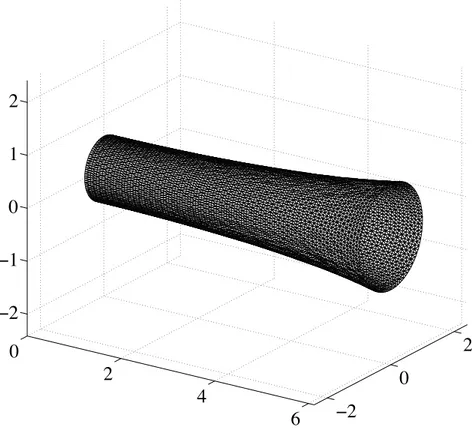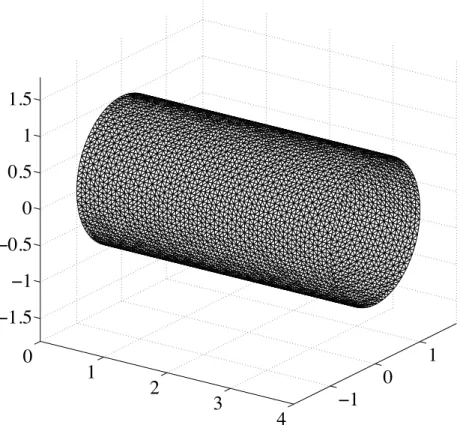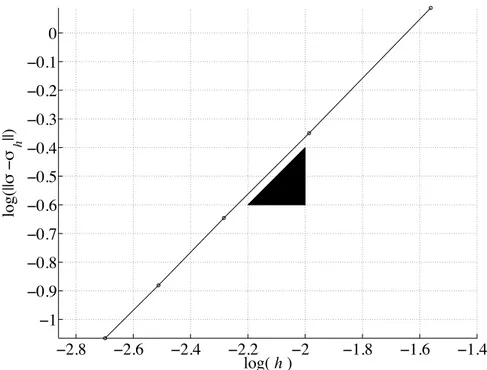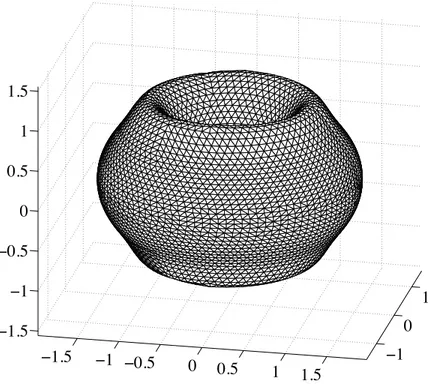Intrinsic finite element
modeling of a linear
membrane shell problem
PETER HANSBO AND MATS G. LARSON
School of Engineering Jönköping University Research Report No. 2012:01
RR
Intrinsic finite element modeling of a linear
membrane shell problem
Peter Hansbo
⇤Mats G. Larson
†Abstract
A Galerkin finite element method for the membrane elasticity problem on a meshed surface is constructed by using two-dimensional elements extended into three dimensions. The membrane finite element model is established using the intrinsic ap-proach suggested by Delfour and Zol´esio [8].
1
Introduction
Models of thin-shell structures are often established using di↵erential geometry to define the governing di↵erential equations in two dimensions, cf. Ciarlet [4] for an overview. A simpler approach is the classical engineering trick of viewing the shell as an assembly of flat elements, in which simple transformations of the two-dimensional sti↵ness matrices are performed, cf., e.g., Zienkiewciz [15]. In contrast to these approaches, Delfour and Zolesio [8, 9, 10] established elasticity models on surfaces using the signed distance function, which can be used to describe the geometric properties of a surface. In particular, the intrinsic tangential derivatives were used for modeling purposes as the main di↵erential geometric tool and the partial di↵erential equations were established in three dimensions. A similar concept had been used earlier in a finite element setting for the numerical discretization of the Laplace-Beltrami operator on surfaces by Dziuk [12], resulting in a remarkably clean and simple implementation. For di↵usion-like problems, the intrinsic approach has become the focal point of resent research on numerical solutions of problems posed on surfaces, cf., e.g., [1, 2, 7, 11, 13, 14]
The purpose of this paper is to begin to explore the possibilities of the intrinsic approach in finite element modeling of thin-shell structures, focusing on the simplest model, that of the membrane shell without bending sti↵ness. We derive a membrane model using the intrinsic framework and generalize the finite element approach of [12]. Finally, we give some elementary numerical examples.
⇤Department of Mechanical Engineering, J¨onk¨oping University, SE-55111 J¨onk¨oping, Sweden.
2
The membrane shell model problem
2.1
Basic notation
We begin by recalling the fundamentals of the approach of Delfour and Zolesio [8, 9, 10]. Let ⌃ be a smooth two-dimensional surface imbedded inR3, with outward pointing normal
n. If we denote the signed distance function relative to ⌃ by d(x), for x 2 R3, fulfilling
rd = n, we can define the domain occupied by the membrane by ⌦t ={x 2 R3 :|d(x)| < t/2},
where t is the thickness of the membrane. The closest point projection p : ⌦t ! ⌃ is given
by
p(x) = x d(x)n(x), the Jacobian matrix of which is
rp = I dr ⌦ n n⌦ n
where I is the identity and⌦ denotes exterior product. The corresponding linear projector P⌃ = P⌃(x), onto the tangent plane of ⌃ at x 2 ⌃, is given by
P⌃:= I n⌦ n,
and we can then define the surface gradient r⌃ as
r⌃ := P⌃r. (2.1)
The surface gradient thus has three components, which we shall denote by
r⌃ =: 2 6 6 6 6 6 6 4 @ @x⌃ 1 @ @x⌃ 2 @ @x⌃ 3 3 7 7 7 7 7 7 5 .
For a vector valued function v(x), we define the tangential Jacobian matrix as
r⌃⌦ v := 2 6 6 6 6 6 6 4 @v1 @x⌃ 1 @v1 @x⌃ 2 @v1 @x⌃ 3 @v2 @x⌃ 1 @v2 @x⌃ 2 @v2 @x⌃ 3 @v3 @x⌃ 1 @v3 @x⌃ 2 @v3 @x⌃ 3 3 7 7 7 7 7 7 5 and the surface divergence r⌃· v := trr⌃⌦ v.
2.2
The surface strain and stress tensors
We next define a surface strain tensor "⌃(u) :=
1
2 r⌃⌦ u + (r⌃⌦ u)
T ,
which is extensively used in [8, 9, 10], where it is employed to derive models of shells based on purely mathematical arguments.
From a mechanical point of view, the problem of using "⌃(u) as a fundamental measure
of strain on a surface lies in it not being an in-plane tensor, in that "⌃(u)·n 6= 0. The shear
strains associated with the out-of-plane direction are typically neglected in mechanical models, but are present in "⌃(u) (cf. Remark 2.1). To obtain an in-plane strain tensor we
need to use the projection twice to define
"P⌃(u) := P⌃"(u)P⌃,
which lacks all out-of-plane strain components. For a shell, where plane stress is assumed, this strain tensor can still be used, since out-of-plane strains do not contribute to the strain energy.
Remark 2.1 It is instructive to work out the details at a surface point whose surrounding is tangential to the x1x2–plane. In this case n = (0, 0, 1),
P⌃ = 2 4 1 0 00 1 0 0 0 0 3 5 , r⌃⌦ u = 2 6 6 6 6 4 @u1 @x1 @u2 @x1 @u3 @x1 @u1 @x2 @u2 @x2 @u3 @x2 0 0 0 3 7 7 7 7 5, "⌃(u) = 2 6 6 6 6 6 6 4 @u1 @x1 1 2 ✓ @u1 @x2 +@u2 @x1 ◆ 1 2 @u3 @x1 1 2 ✓ @u1 @x2 + @u2 @x1 ◆ @u2 @x2 1 2 @u3 @x2 1 2 @u3 @x1 1 2 @u3 @x2 0 3 7 7 7 7 7 7 5 , and "P⌃ = 2 6 6 6 6 4 @u1 @x1 1 2 ✓ @u1 @x2 + @u2 @x1 ◆ 0 1 2 ✓ @u1 @x2 +@u2 @x1 ◆ @u2 @x2 0 0 0 0 3 7 7 7 7 5.
The terms in "⌃ not present in "P⌃ are shear strains that are typically neglected for thin
structures, and it is clear that in our case "P
However, the tensor "P
⌃ is rather cumbersome to use directly in a numerical
implemen-tation; it would be much easier to work with "⌃ which can be establish using tangential
derivatives. For this reason, we use the fact that there also holds (as is easily confirmed) "P⌃(u) = P⌃"⌃(u)P⌃ =
1
2 P⌃r⌃⌦ uP⌃+ (P⌃r⌃⌦ uP⌃)
T ,
and since n· "⌃(u)· n = 0 we have the following relation:
"P
⌃(u) = "⌃(u) (("⌃(u)· n) ⌦ n + n ⌦ ("⌃(u)· n)) ,
so that, using dyadic double-dot product,
: u⌦ v = ( · u) · v, u ⌦ v : = u· (v · ), where is a tensor and u, v are vectors, we arrive at
"P⌃(u) : "P⌃(v) = "⌃(u) : "⌃(v) 2("⌃(u)· n) · ("⌃(v)· n), (2.2)
which will be used in the finite element implementation below. We also note that there holds
tr "P⌃(v) =r⌃· v, (2.3)
where tr" =Pk"kk.
We shall assume an isotropic stress–strain relation, = 2µ" + tr" I,
where is the stress tensor and I is the identity tensor. The Lam´e parameters and µ are related to Young’s modulus E and Poisson’s ratio ⌫ via
µ = E
2(1 + ⌫), =
E⌫
(1 + ⌫)(1 2⌫). For the in-plane stress tensor we thus assume
P
⌃ := 2µ"P⌃+ tr"P⌃P⌃,
in the plane strain case and, in the plane stress case, which is appropriate for a thin membrane, P ⌃ := 2µ"P⌃ + 0tr"P⌃P⌃, (2.4) where 0 := 2 µ + 2µ = E⌫ 1 ⌫2.
2.3
The membrane shell equations
Consider a potential energy functional given by ⇧(ut) := 1 2 Z ⌦t (ut) : "(ut)d⌦t Z ⌦t ft· ut
where ft is of the form ft= f p. Under the assumption of small thickness, we have Z ⌦t f (x) d⌦t ⇡ Z t/2 t/2 Z ⌃ f d⌃dz and thus ⇧(ut)⇡ ⇧P⌃(u) := t 2 Z ⌃ P ⌃(u) : "P⌃(u)d⌃ t Z ⌃ f · u d⌃ := t 2( P ⌃(u), "P⌃(u))⌃ t(f , u)⌃.
Minimizing the potential energy leads to the variational problem of finding u 2 V , where V is an appropriate Hilbert space which we specify below, such that
a⌃(u, v) = l⌃(v) 8v 2 V (2.5)
where, by (2.2) and (2.3),
a⌃(u, v) = (2µ"P⌃(u), "P⌃(v))⌃+ ( 0tr "P⌃(u), tr "P⌃(v))⌃
= (2µ"⌃(u), "⌃(v))⌃ (4µ"⌃(u)· n, "⌃(v)· n)⌃+ ( 0r⌃· u, r⌃· v)⌃,
and l⌃(v) = (f , v)⌃. This variational problem formally coincides with the one analyzed
in the classical di↵erential geometric setting by Ciarlet and co-workers [6, 5], as shown in [10].
Splitting the displacement into a normal part un := u· n and a tangential part ut :=
u unn we have the identity
"P⌃(u) = "P⌃(ut) + unr ⌦ n = "P⌃(ut) + un,
where = r ⌦ rd is the Hessian of the distance function d, cf. [10], The bilinear form can therefore also be written in the form
a⌃(u, v) = (2µ("P⌃(ut) + un), "P⌃(vt) + vn)⌃
+ ( 0(tr "P⌃(ut) + untr ), tr "P⌃(vt) + vntr )⌃ (2.6)
This means that we do not have full ellipticity in our problem. Based on this observation we conclude that the natural function space for the variational formulation is
cf. [5]. The loss of ellipticity have consequences for the numerics and we comment on this in the numerical examples below.
Since
( P⌃(u), "P⌃(u))⌃ = ( P⌃(u), "⌃(u))⌃
we find, using Green’s formula, the pointwise equilibrium equation
r⌃· P⌃(u) = f in ⌃, (2.7)
which together with the constitutive law (2.4) defines the intrinsic di↵erential equations of linear elasticity on surfaces.
3
The finite element method
3.1
Parametrization
Let Th := {T } be a conforming, shape regular triangulation of ⌃, resulting in a discrete
surface ⌃h. We shall here consider an isoparametric parametrization of the surface (the
same idea can however be used for arbitrary parametrizations). In the numerical examples below we use a piecewise linear approximation, meaning that the elements T will be planar. For the parametrization we wish to define a map F : (⇠, ⌘) ! (x, y, z) from a reference triangle ˆT defined in a local coordinate system (⇠, ⌘) to T , for all T . To this end, we write x = x(⇠, ⌘), where x = (x, y, z) are the physical coordinates on ⌃h. For any given
parametrization, we can extend it outside the surface by defining x(⇠, ⌘, ⇣) = x(⇠, ⌘) + ⇣ n(⇠, ⌘)
where n is the normal and t/2 ⇣ t/2. In some models, where the surface is an idealized thin structure, it is natural to think of t as a thickness.
For the representation of the geometry, we first introduce the following approximation of the normal: n⇡ nh = nh0 |nh 0| , nh0 =X i ni'i(⇠, ⌘),
where 'i(⇠, ⌘) are the finite element shape functions on the reference element (assumed
linear in this paper), and ni denotes the normals in the nodes of the mesh. We then
consider parametrizations of the type
x(⇠, ⌘, ⇣)⇡ xh(⇠, ⌘, ⇣) =X i
(xi'i(⇠, ⌘) + ⇣ ni'i(⇠, ⌘)) (3.1)
where xi are the physical location of the nodes on the surface. For the approximation of
the solution, we use a constant extension, u⇡ uh =X
i
where ui are the nodal displacements, so that the finite element method is, in a sense,
superparametric. Note that only the in-plane variation of the approximate solution will matter since we are looking at in-plane stresses and strains. We employ the usual finite element approximation of the physical derivatives of the chosen basis {'i} on the surface,
at (⇠, ⌘), as 2 6 6 6 6 6 4 @'j @x @'j @y @'j @z 3 7 7 7 7 7 5 = J 1(⇠, ⌘, 0) 2 6 6 6 6 6 4 @'j @⇠ @'j @⌘ @'j @⇣ 3 7 7 7 7 7 5 ⇣=0 where J (⇠, ⌘, ⇣) := 2 6 6 6 6 6 6 4 @xh @⇠ @yh @⇠ @zh @⇠ @xh @⌘ @yh @⌘ @zh @⌘ @xh @⇣ @yh @⇣ @zh @⇣ 3 7 7 7 7 7 7 5 , This gives, at ⇣ = 0, 2 6 6 6 6 6 4 @'i @x @'i @y @'i @z 3 7 7 7 7 7 5 = J 1(⇠, ⌘, 0) 2 6 6 6 4 @'i @⇠ @'i @⌘ 0 3 7 7 7 5. With the approximate normals we explicitly obtain
@xh @⇣ ⇣=0= n h, so J (⇠, ⌘, 0) := 2 6 6 6 6 4 @xh @⇠ @yh @⇠ @zh @⇠ @xh @⌘ @yh @⌘ @zh @⌘ nhy nhy nhz 3 7 7 7 7 5.
Remark 3.1 The approach by Dziuk [12] (and also the classical engineering approach, [15]) is, in our setting, a constant-by-element extension of the geometry using facet triangles {T } so that, with nT the normal to the facet, xh(⇠, ⌘, ⇣) T =Pixi 'i(⇠, ⌘)|T + ⇣nT, and
2 6 6 6 6 6 4 @'i @x @'i @y @'i @z 3 7 7 7 7 7 5 = J 1(⇠, ⌘, 0) 2 6 6 6 6 4 @'i @⇠ @'i @⌘ 0 3 7 7 7 7 5, J (⇠, ⌘, 0) := 2 6 6 6 6 4 @xh @⇠ @yh @⇠ @zh @⇠ @xh @⌘ @yh @⌘ @zh @⌘ nT x nT y nT z 3 7 7 7 7 5.
This low order approximation has the advantage of yielding a constant Jacobian from a linear approximation. For some applications this is, however, o↵set by the problem of having a discontinuous normal between elements.
3.2
Finite element formulation
We can now introduce finite element spaces constructed from the basis previously discussed by defining
Wh :={v : v|T F 2 Pk( ˆT ), 8T 2 Th; v 2 C0(⌃h)}, (3.3)
(in the numerics, we use k = 1), and the finite element method reads: Find uh 2 Vh :=
[Wh]3 such that
a⌃h(uh, v) = l⌃h(v), 8v 2 V
h, (3.4)
where
a⌃h(u, v) = (2µ"⌃h(u), "⌃h(v))⌃h (4µ"⌃h(u)· n
h, " ⌃h(v)· n h) ⌃h + ( 0r⌃h· u, r⌃h· v)⌃h and l⌃h(v) = (f , v)⌃h.
3.3
Extension to surfaces with a boundary
If the surface ⌃ has a boundary @⌃ we assume that @⌃ = [i@⌃i where @⌃i are closed
components. On each of the components @⌃i we let qj : @⌃i ! R3, j = 1, 2, 3, be smooth
orthonormal vector fields. We strongly impose homogeneous Dirichlet boundary conditions of the type
qj· u = 0 on @⌃i, 1 j di, (3.5)
where di = 1, 2, or 3, and weakly the remaining Neumann condition
(n@⌃· P⌃(u))· qj = 0, di < j 3, (3.6)
where n@⌃ is the unit vector that is normal to @⌃ and tangent to ⌃. Note that not every
combination of boundary conditions and right hand side leads to a well posed problem.
4
Numerical examples
In the numerical examples below, the geometry is represented by flat facets, and the normals are taken as the exact normal in the nodes, interpolated linearly inside each element. Our experience is that similar results are obtained if we use L2 projections of
the flat facet normals in the nodes and then interpolate these linearly.
4.1
Pulling a cylinder
We consider a cylindrical shell of radius r and thickness t, with open ends at x = 0 and at x = L, and with fixed longitudinal displacements at x = 0, and radial at x = L, carrying a horizontal surface load per unit area
f (x, y, z) = F 2⇡r
x L2,
where F has the unit of force. The resulting longitudinal stress is
= F 1 (x/L)
2
4⇡rt .
We take as an example a cylinder of radius r = 1 and length L = 4, with material data E = 100 and ⌫ = 1/2, with thickness t = 10 2, and with F = 1. In Fig. 1 we
show the solution (exaggerated 10 times) on a particular mesh (shown in Fig. 2). Note that the lateral contraction creates radial displacements depending on the size of stress. Finally, in Fig. 3 we show the L2 error in stresses, k hkL2(⌦), where :=
P
⌃(u) and h := P⌃(uh), which shows the expected first order convergence for our P1approximation.
The black triangle shows the 1:1 slope.
4.2
A torus with internal pressure
We consider a torus with internal gauge pressure p for which the stresses are statically determinate. Using the angle and radii defined in Fig. 4, the principal stresses are given by 1 = pr 2t, 2 = pr t ✓ 1 r sin ✓ 2(R + r sin ✓) ◆ ,
where 1 is the longitudinal stress, 2 the hoop stress, and t is the thickness of the surface
of the torus. The constitutive parameters and thickness where chosen as in the cylinder example, and we set R = 1, r = 1/2, and p = 1.
Again we compute the stress error k hkL2(⌦). We show the observed convergence
in Fig. 7 at a rate of about 3/4 (the slope of the black triangle), which is suboptimal, but does occur in problems where elliptic regularity is an issue, cf. [3], Lemma 10. We thus attribute this loss of convergence to the load now being in the normal direction of the shell, for which we do not have ellipticity.
References
[1] E. B¨ansch, P. Morin, and R. H. Nochetto. Surface di↵usion of graphs: variational formulation, error analysis, and simulation. SIAM J. Numer. Anal., 42(2):773–799, 2004.
[2] J. W. Barrett, H. Garcke, and T. N¨urnberg. On the parametric finite element ap-proximation of evolving hypersurfaces in R3. J Comput. Phys., 227(9):4281 – 4307,
2008.
[3] E. Burman and P. Hansbo. Edge stabilization for Galerkin approximations of convection-di↵usion-reaction problems. Comput. Methods Appl. Mech. Engrg., 193(15-16):1437–1453, 2004.
[4] P. G. Ciarlet. Mathematical elasticity. Vol. III: Theory of shells, volume 29 of Studies in Mathematics and its Applications. North-Holland Publishing Co., Amsterdam, 2000.
[5] P. G. Ciarlet and V. Lods. Asymptotic analysis of linearly elastic shells. I. Justification of membrane shell equations. Arch. Rational Mech. Anal., 136(2):119–161, 1996. [6] P. G. Ciarlet and ´E. Sanchez-Palencia. Un th´eor`eme d’existence et d’unicit´e pour les
´equations des coques membranaires. C. R. Acad. Sci. Paris S´er. I Math., 317(8):801– 805, 1993.
[7] K. Deckelnick, G. Dziuk, C. M. Elliott, and C.-J. Heine. An h-narrow band finite-element method for elliptic equations on implicit surfaces. IMA J. Numer. Anal., 30(2):351–376, 2010.
[8] M. C. Delfour and J.-P. Zol´esio. A boundary di↵erential equation for thin shells. J. Di↵erential Equations, 119(2):426–449, 1995.
[9] M. C. Delfour and J.-P. Zol´esio. Tangential di↵erential equations for dynamical thin/shallow shells. J. Di↵erential Equations, 128(1):125–167, 1996.
[10] M. C. Delfour and J.-P. Zol´esio. Di↵erential equations for linear shells: comparison between intrinsic and classical models. In Advances in mathematical sciences: CRM’s 25 years (Montreal, PQ, 1994), volume 11 of CRM Proc. Lecture Notes, pages 41–124. Amer. Math. Soc., Providence, RI, 1997.
[11] A. Demlow and G. Dziuk. An adaptive finite element method for the Laplace-Beltrami operator on implicitly defined surfaces. SIAM J. Numer. Anal., 45(1):421–442, 2007. [12] G. Dziuk. Finite elements for the Beltrami operator on arbitrary surfaces. In Par-tial di↵erenPar-tial equations and calculus of variations, volume 1357 of Lecture Notes in Math., pages 142–155. Springer, Berlin, 1988.
[13] C. M. Elliott and B. Stinner. Modeling and computation of two phase geometric biomembranes using surface finite elements. J Comput. Phys., 229(18):6585 – 6612, 2010.
[14] M. A. Olshanskii, A. Reusken, and J. Grande. A finite element method for elliptic equations on surfaces. SIAM J. Numer. Anal., 47(5):3339–3358, 2009.
[15] O. C. Zienkiewicz. The finite element method in engineering science. McGraw-Hill, London, 1971.
0
2
4
6
2
0
2
2
1
0
1
2
0
1
2
3
4
1
0
1
1.5
1
0.5
0
0.5
1
1.5
2.8 2.6 2.4 2.2 2 1.8 1.6 1.4 1 0.9 0.8 0.7 0.6 0.5 0.4 0.3 0.2 0.1 0 log( h ) log(|| h ||)
θ r
R
Figure 4: A cut through of the torus
2 1 0 1 2 1 0 1 0.5 0 0.5
1.5 1 0.5 0 0.5 1 1.5 1 0 1 1.5 1 0.5 0 0.5 1 1.5
3 2.9 2.8 2.7 2.6 2.5 2.4 2.4 2.3 2.2 2.1 2 1.9 1.8 log( h ) log(|| h ||)





